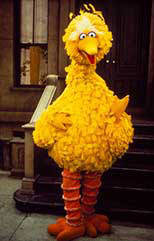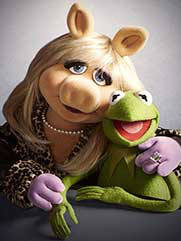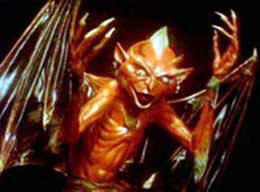
History
Others
Puppets

In the mid-fifties, USA audiences were introduced to the creations of Jim Henson - the muppets. Although Jim insisted until his premature death in 1991 that the name was chosen simply because he liked the sound of it, his wife Jane recalled the word 'Muppet' being a fusion of the words 'puppet' and 'marionette'. They were a far cry from many of the puppets used on British television at that time. In that period in history, the vast majority were made of hard, relatively inflexible material. In contrast, the muppets were very flexible. This enabled them to be very expressive, and was perfect for the medium of the small screen. The muppets varied from hand puppets to people dressed up in costume, but were usually a combination of the hand and rod puppet. Most of today's television puppetry has been influenced by Jim Henson's muppet creations.
Jim's fertile imagination first brought the mad world of the muppets to American viewers as a series of short five minute sketches under the banner Sam and Friends. Later he was given a spot on The Jimmy Dean Show, which elevated piano playing Rowlf the Dog into a regular attraction. Rowlf was the first muppet star, but Jane Henson recollects that overall 'there was just commercials and guest spots on other peoples' shows'. Nobody was prepared to give the muppets a show of their own.
In 1969, a children's programme that could be used to 'reach out to the underprivileged inner city youngsters' of America was proposed. After it was decided that Jim Henson's muppets would be a valuable asset to the fledgling show, Sesame Street was born. For once, children were not looked down upon, and were assumed equal intelligence to adults, although the vocabulary was simplified. That was not the only major difference to previous children's entertainment shows. Joan Ganz Cooney, the woman in charge of the study that proposed the programme, explains, 'I wanted a hip type of show, with humour that children would get something out of, but the adults and older siblings would enjoy too.' Looking at the great children's literature, such as Alice in Wonderland, it is apparent that they are built on a number of different levels. Sesame Street adopted this principle. The parents could sit down with their children, and not be bored witless. The show is available to everyone due to its multi-layered sketches. Parodies of countless adult programmes have been acted out by the muppets. Not many toddlers would ever have seen the adult show Masterpiece Theatre, but they laughed at the Cookie Monster's Monsterpiece Theatre. Similarly, Miami Mice caused a smile to be raised. Sesame Street allowed adults to 'renter their childhood, without abandoning their adult dignity.' The show became a huge hit all over the world, making the muppets a household name, but unfortunately for Jim it was still a children's show.
The American networks were unconvinced of the muppets appeal for an adult audience. As with Thunderbirds years earlier, it was Lew Grade from the British television company ATV that stepped in. The Muppet Show, a fully-fledged family puppet series hit UK audiences in 1976. Viewers were introduced to a whole variety of muppets, haphazardly attempting to run a theatre in their own unique way. Each week they had a human guest star to humiliate. People turned on in droves to watch the respected ballet dancer Rudolf Nureyev dance with an enormous, tutu-clad pig. The Muppet Show was a roaring success and delighted viewers of all ages. Scheduled at primetime status on ITV, the series obtained fantastic viewing figures and was often in the top twenty. Its best year was 1978, when The Muppet Show was the fifth most watched programme of the year, reaching 20.6 million people throughout its UK run.
Jim Henson's sense of fun must go a long way to ensuring the popularity of the programme. His madcap humour was truly on two levels. There were visual gags for all ages, plus subtexts which the grown-ups could laugh at. Innuendo, parody and social comment were evident, as were slapstick, puns and furry creatures. There was plenty to keep anyone, whatever the age, entertained. There were many human qualities reflected in the muppet characters. Ted Koppel, broadcast journalist, believes that 'we can all see a little bit of ourselves in Kermit, and wish we only had Kermit's panache.' There are indeed many qualities in this small green frog that could relate to many people. It is these human qualities that makes his character so appealing. Similarly so for the other characters, whether they be the failed comic Fozzie Bear or Gonzo the Great. Gonzo is certainly one of the oddest muppets. He has shown many symptoms of a masochist and has an attraction to poultry. 'Nice Legs!', he comments to a dancing chicken in one episode. These jokes are very adult, but the slapstick he portrays in-between relate very much to the kids.
However popular and entertaining The Muppet Show was, Jim Henson's brief 1987 series, The Storyteller, was his masterpiece. The Storyteller took folk tales and presented them in the traditional way. The originator of the idea, Jim's eldest daughter Lisa, recalls 'I discovered these wonderful old tales. I began to think it would be great fun to tell these folk tales the way they were written. Not violent, necessarily, but not sugar-coated, not glamorised, and not just handsome princes and beautiful princesses. A little darker than people are used to.'
Nobody had ever attempted to bring a fairy tale to television, whilst staying true to the oral tradition without the standard television dramatisation. The Storyteller's format involved an unnamed man sitting in front of a roaring fire, spinning out his yarn to his audience - a puppet dog. As the storyteller unravels the tale, the characters would come to life out of the embers of the fire, or at the side of the room. The television audience would then follow into the storyland world, as if it was in their own minds. The storyteller's voice was always in evidence, keeping in touch with the ancient oral tradition. The puppets of animals, monsters and devils were believable, making good use of the animatronic remote control devices that Jim had perfected over the years to add naturalistic facial expressions. The puppets interacted with the live characters, never drawing a line between reality and fantasy.
The Storyteller brought Jim Henson's puppetry to a far more adult level. Many children would have found it too dark and scary. In times long past puppets, in a far more basic way, would have been used in the telling of folk tales. The Storyteller was not only an echo of the old oral tradition, but one of the original use of puppets. Jim Henson believed that The Storyteller was is finest triumph. It is also the closest that television has ever gone to capturing the true meaning of puppet art.
Jim Henson's Muppets
The Muppet Show's Kermit & Miss Piggy (Left)
A Devil From The Storyteller (Above)
Sesame Street's Big Bird (Right)





This website is the copyright of Benjamin Burford-Jones 2014, except quotations and photographs used to illustrate various traditional and television puppets.
No material should be reproduced in any form whatsoever for purposes of commercial gain without obtaining the copyright holder’s express permission.
Herb the Owl | Alex the Droog | What is a Puppet | Watching With Mother | Gerry Anderson | Jim Hensons Muppets
From Satire to Sitcom | Are Puppets Just for Kids | About the Author and Links















